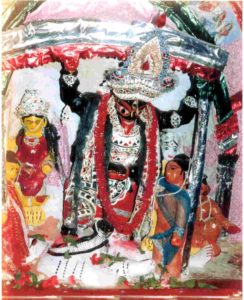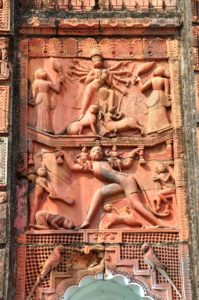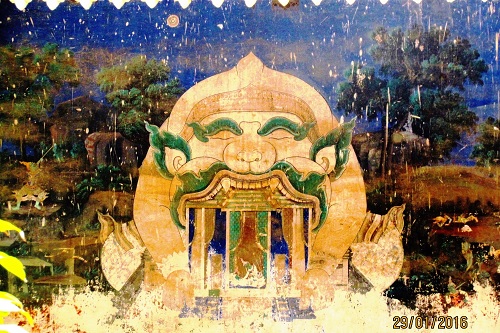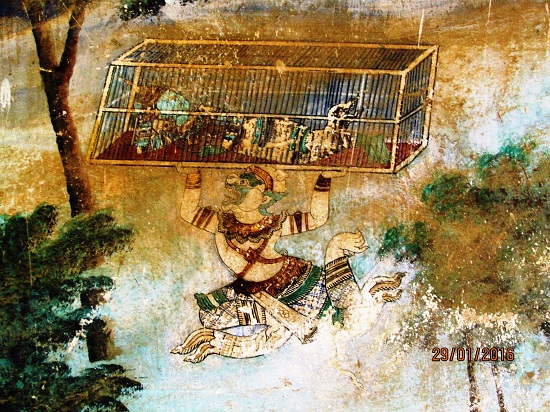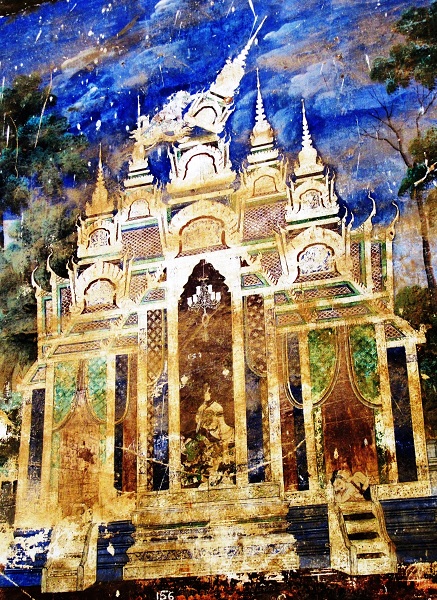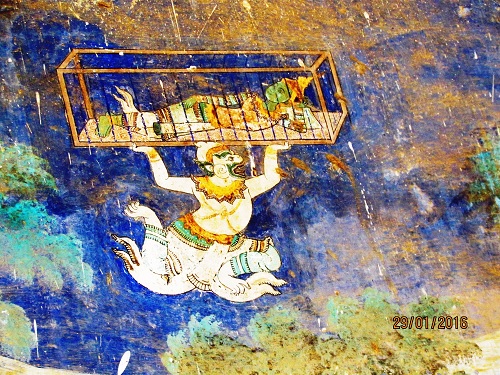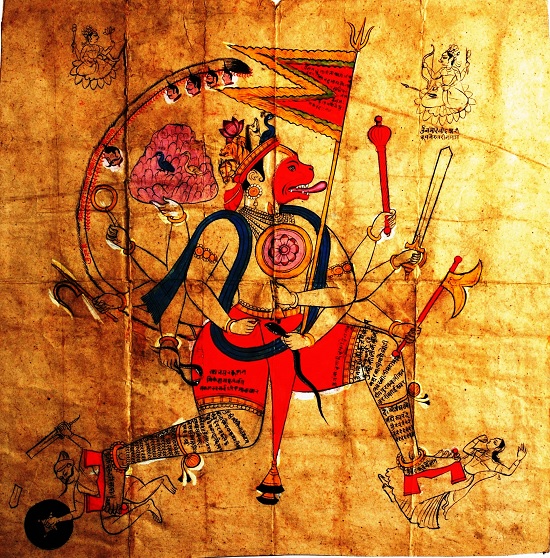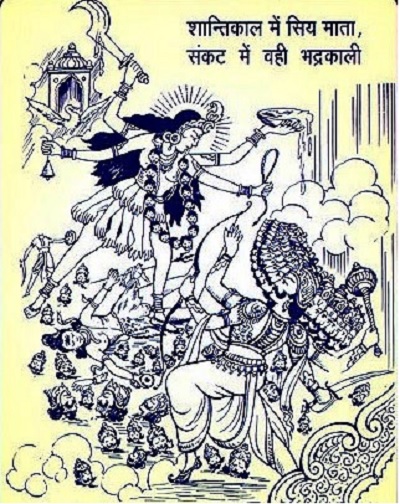| The record of foreign invasions in India’s own itihasa is not available in any systematic form. However, the references to foreign tribes are several, as in the Vashishtha-Vishvamitra conflict, Sagara’s conquests, the Rajasuya sacrifice, the Kurukshetra war and Kalayavana’s attack. What we do not find is accounts of foreign rulers except in the cryptic statements regarding the descendants of Yayati’s four sons, Yadu, Turvasu, Anu, Druhyu. In historical times when the Arabs and Mughals invaded and settled down here, they found that to understand Indians it was necessary to comprehend the two poetic compositions that appeared to wield overpowering influence over the population. The unfortunate fact is that in modern India there has been no effort to study what these foreigners made of the Ramayana and theMahabharata. The only papers available are quite old: R.G. Harshe’s on the Arabic version of the Mahabharata (Bulletin of the Deccan College Research Institute, Pune, Vol.2), and the studies by M.A. Chaghatai (BDCRI, vol.5) and J.J. Modi (ABORI, vol.6) on Akbar’s illustrated edition of the Persian Razm Nama (the Book of War, as Akbar named the Mahabharata).
The first Arabic text on the Mahabharata belongs to the 11th century AD. In 1845 M. Reinaud, Membre de l’Institut, Paris, published a book containing French translations of Arabic and Persian fragments about India with a chapter entitled, “History of the kings of India and their chronological order according to the information which has come to our knowledge”. This was a translation thrice removed, being a French version of the Persian work Modjmel-altevarykh (1125 AD) by Abul-Hasan-Ali, keeper of the city library of Jurjan located near the Caspian seashore, written for a chieftain of the Dilemites. This Persian work was itself a translation of the Arabic “Instruction of the Princes” (1026 AD) by Abu-Saleh who had translated it from the Sanskrit. The first Arab invasion was of Sind in the early 9th century AD, co-terminus with the Umayyad invasion of Spain. Kunti’s narration of the Vidula’s fiery exhortation to her son Sanjaya in the Udyoga Parva of theMahabharata could have this in the background. Abu-Saleh’s work contains not only the Mahabharata story but also others that have not been identified. A summary, based on Harshe’s paper, is given below of what is found in the French translation pertaining to the Mahabharata. Typically, it begins with Sind.
This version is veritably Hamlet without the prince of Denmark, for where is Krishna? His absence is, indeed, most intriguing. In the early 9th century AD Khalifa Al-Mamun, son of Haroun-al-Rashid, who had two Hindu doctors in his court, used to hold religious conferences like Akbar in which Sanskrit knowing scholars were included. Indian medical works of Charaka and Sushruta were translated into Arabic in the court of the Pahlavi Gajashta Abalis (c. 825 AD). The Tarikh-i-Ferishta records that Feroze Shah Tughlaq got some Sanskrit works lying in a Hindu temple in Nagarkote (Nagrota in Kangra valley) translated into Persian. According to the local legend Alexander had placed an image of his wife Nowshaba here, which was worshipped by the Brahmins as Jwalamukhi. Akbar got as many as 15 Sanskrit texts translated into Persian. These were: Atharbedby Badaoni and others; Bhagwad Gita by Faizi and another; Gangadhar by Abul Fazl; Haribans by Maulana Sheri; Jog-Bashishta by Maulana Faraniuli; Katha Sarit Sagara by Badaoni; Kishen Joshi by Abul Fazl; Lilavati and Nal Daman by Faizi;Mahesh Mohanand by Abul Fazl; Singhasana Battisi by Badaoni, called “Nama-i-Khird Afza”; Tajak on astronomy by Muhammad Khan; treatise on elephants by Mulla Sheri; Ramayana and Mahabharata by Badaoni and others. Abdul Qadir Badaoni records that in 1582 AD Akbar felt that instead of translating fictitious narratives like Ferishta’s it would be worthwhile to get translated into Persian the rich material of philosophy and history in the Mahabharata for the edification of his nobles. Badaoni states that it narrates the wars of the tribes of Kurus and Pandus who ruled in Hind more than 4000 years ago, which the people commonly say is over 80,000 years ago. Akbar took personal interest in the enterprise, explaining the meaning to Naqib Khan the first few nights so that he could make a Persian summary. Some of the Sanskrit scholars who were called in to assist were: Debi Misra, Satavadana, Madhusudana Misra, Rudra Bhattacaraj, Chaturbhuja, Sheikh Bhawan (a Dakhini Brahmin converted into Islam). Of these Debi Misra (author of Bharata artha dipika), Chaturbhuja Misra (author of Bharata upaya prakasaka bharata tatparya prakashika) are from Bengal, well known for their commentaries on the epic. Madhusudana Misra edited the play Mahanatakam. They assisted Naqib Khan, Shaikh Sultan (Haji) Thanesari, Mulla Sheri and Abdul Qadir Badauni who wrote the text in Persian. Razmnama is not an exact translation but a free Persian adaptation, as Badaoni states. Badaoni translated two of the 18 books. In 1588 he finished translating the Ramayana for which he received 150 Ashrafis and 10,000 tangahs, the Singhasan Battisi as “Nameh-i Khirad-Afza” and the Atharva Veda in which he found that Hindus eat beef, bury their dead and that it has a passage guaranteeing salvation that resembles the Muslim “La-illah illa ‘llah”. Mulla Sheri (who also translated the Harivamsa asHaribans, which Albiruni says is an authority on Indian matters) and Naqib Khan did a part. The rest was finished by Sultan Haji of Thanessar. Faizi, Abul Fazl’s brother and Akbar’s personal friend, converted two books into elegant language. Sultan Haji further revised these two and his own portion for over four years, carefully checking against the original, saying, “I render into modern language the knowledge of 10,000 years.” Badaoni, on the other hand, calls it as “puerile absurdities, of which the 18000 creations may well be amazed…Two parts were written. Such discussions as one never heard! As, Shall I eat forbidden things? Shall I eat turnips? But such is my fate to be employed on such works…But the Emperor took exception to my translation and called me a Haramkhur and a turnip-eater, as if that was my share of the book.” He felt that all the translators were destined for hell. Akbar suspected him of importing his bigoted ideas into the translation and Badaoni had to defend himself at length over a passage in the Shanti Parva dealing with rebirth. The first draft of the text was completed in August-September 1584 and contained translations of one lakh verses of the epic. It was then copied by expert calligraphists. Abul Fazl wrote a lengthy preface. According to him, recital of the Harivamsha was known to cure sterility. After the text was prepared, Akbar asked his court artists to illustrate it. Prominent among these master artists were Daswant, Basawan, Lal, Mukund, Kesav, Muhammad Sharif and Farrukh Chella who produced some of the finest specimens of Mughal miniature painting. There are 168 paintings in Akbar’s copy (the Ramayana translation has 176). It was bound in four lavish volumes and presented to the emperor who named it Razmnama, The Book of War. The Sanskrit word “bhaara” means “war”, as in the play Karnabhaara. Akbar asked his nobles to get copies made for their own study. Akbar’s own copy, acquired by Maharaja Sawai Jai Singh of Jaipur in the 1740s, is in the Maharaja Sawai Mansingh-II Museum in Jaipur City Palace, unavailable for study owing to court cases. Jai Singh ripped off the gold-embroidered goat-skin covers of the original like a vandal on religious grounds. Another copy of lesser quality was produced in 1598-1599. Most of the other illustrated Razmnama are lost or scattered all over the world in museums and personal collections. One was prepared for Jahangir’s commander-in-chief, Abdur Rahim Khankhanan, in 1616-17, which too has been dispersed across the world. In 1602 AD Tahir Muhammad prepared an abridgement of the Persian translation including the Harivamsha. Firishta states in the introduction to his history of India and Hindus that he used the Razmnama as his source. Unfortunately, the editors of the critical edition of the Mahabharata did not study the Razmnama to check what episodes featured in the epic in the 16th century, which would have enabled us to determine what, if any, has been interpolated since then. The parva-wise summary of contents of the Persian adaptation are given below as stated by the translators, indicating the number of verses in the original (southern recension) and the Persian separately as in Chaghatai’s paper. The differences in names of characters of the later parvas show Thanesari’s correction of Naqib Khan and others’ errors in the earlier parts.
Recently Mapin Publishing has brought out the Birla Razmnama edited by Prof. Asok Kumar Das (formerly curator of the Sawai Man Singh museum in Jaipur) containing the paintings. This Birla Razmnama, kept in the Birla Academy of Art and Culture, Kolkata, is a signed work of Mir Sayyid Ali Tabrizi Judai in three volumes with 629 folios including 84 full-size miniatures by the court artists of Akbar. Its scribe is Pir Muhammad bin Muhammad Hafiz and it is dated the year of Akbar’s death, 1605 AD. Das has pointed out that when compared to the Jaipur Razmnama, “the subjects vary widely.” Some stories chosen are not common and some others that are depicted in more than one miniature in the Jaipur copy have been condensed into one in the Birla copy. The Ashvamedhaparva is of particular interest because, as Das writes, “The exploits of the sacrificial horse—related in the Ashvamedhika parva—are shown in 47 illustrations in the Jaipur copy, 22 in the 1598-99 copy against only four in the Birla copy.” In fact, as Shekhar Sen has pointed out, there are five illustrations, not four. Das has missed the fifth one, plate 79. In the Razmnama this particular parva is taken from Jaimini, not Vyasa. The episodes depicted in the Birla copy are those of Babhruvahana, Yudhisthira’s yajna, Anushalva, Hamsadhvaja and the demon Bhishana. Why did the authors of most of the medieval vernaculars, especially the eastern, prefer Jaimini to Vyasa? Vyasa had asked each of his four disciples to compose their versions of his work. Of these, only Jaimini’s single parva exists today. This version is much more sensational. Vyasa’s parva is full of philosophical issues that do not appeal to the ordinary reader and the tour of the horse is very brief. Arjuna runs through the opposition, stumbling only once at Manipura (also called Manalura, located near Madurai). After the tumultuous war books the story of these battles comes as a damp squib. Jaimini, however, is full of action, variety, color and a series of absorbing stories with few philosophical outpourings. It celebrates the exploits of the children of the heroes slain in the great war and Arjuna comes off quite poorly. In addition, it is liberally spiked with Krishna-bhakti, which must have appealed particularly to the sensibilities of medieval readers and re-tellers. For these reasons, perhaps, the Jaimini parva almost invariably replaced Vyasa’s Ashvamedhika Parva in later renderings of the Mahabharata. Jaimini has not been accessible to the English reading public so far. The first shloka-by-shloka English translation by Major General Shekhar Sen has now been published by Writers Workshop, Kolkata to sate the curiosity of Indologists. |

 There is an image of Kali in the Lalgola palace temple that is unique. Its four hands are bereft of any weapon. The two lower hands are folded in front (karabadhha), the palm of one covered by that of the other, just as a prisoner’s hands are shackled. From behind, the image is shackled to the wall with numerous iron chains. Kali is black, of terrifying mien, naked, a serpent between her feet, and Shiva a supine corpse before her. This represented to Bankim what Bhaarat, the Mother, had become:
There is an image of Kali in the Lalgola palace temple that is unique. Its four hands are bereft of any weapon. The two lower hands are folded in front (karabadhha), the palm of one covered by that of the other, just as a prisoner’s hands are shackled. From behind, the image is shackled to the wall with numerous iron chains. Kali is black, of terrifying mien, naked, a serpent between her feet, and Shiva a supine corpse before her. This represented to Bankim what Bhaarat, the Mother, had become: